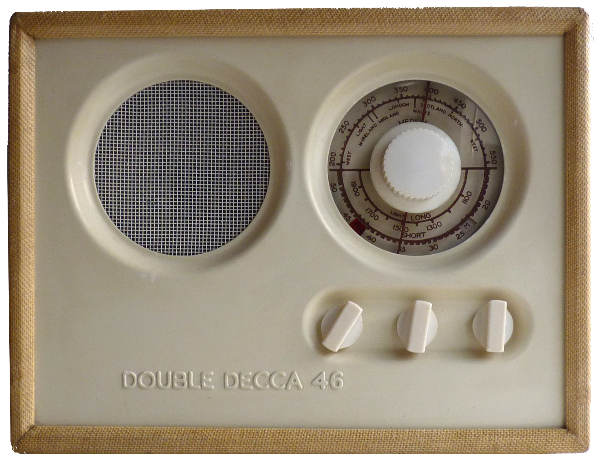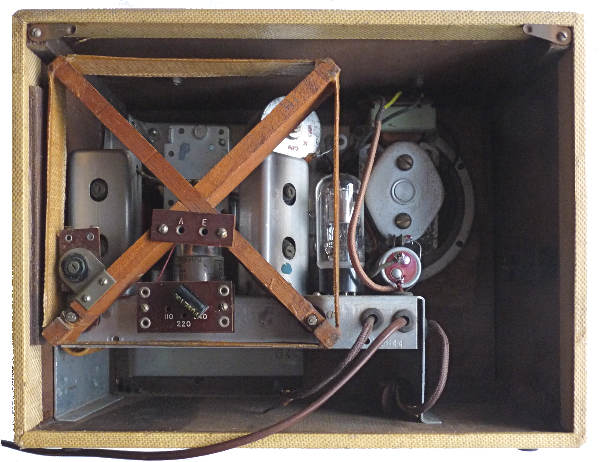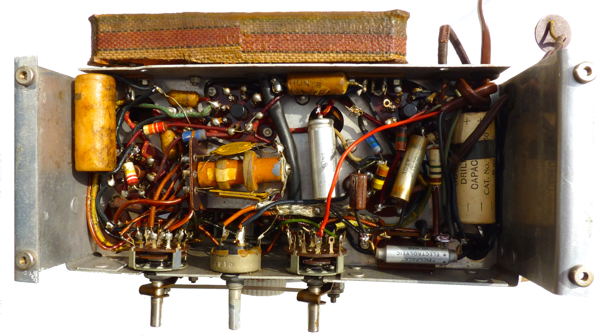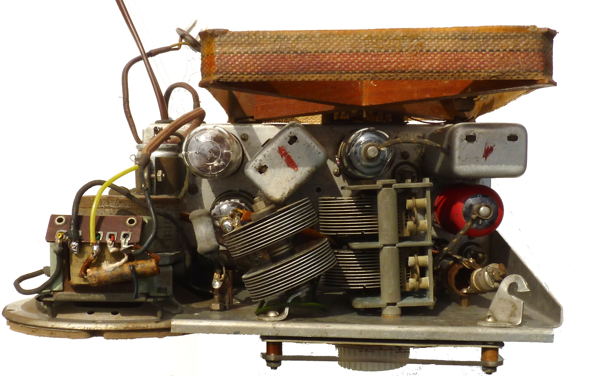
serial No. 13844

DOUBLE DECCA 46 Valve Radio. This is a three waveband (L,M and S) mains/battery set first introduced in this style in 1946 currently fitted with octal based valves DK32 1N5G 1H5G DL33 and metal rectifier. The set was designed to use Osram valves X14 Z14 HD14 N15 but because of a shortage of valves after WW2 modifications were made to use 3Q5G (or DL33) on the output. The radio shown and described here is a later model (possibly 1948) . It is housed in a plywood case covered in an embossed "leatherette" type fabric, the front panel is of pressed aluminum sheet sprayed cream. The set was designed to operate on AC or DC mains 100-120V, 200-220V,230-250V or a 90 Volt (Ever Ready B107) battery and a 7.5 Volt (Ever Ready "All Dry" 31) battery.
As far as I have been able to find out these are the variations:
Double Decca 46 had three circuit variations [ser nos. 5000-6000, ser nos. 7000-8000 and ser no 8000 onwards] The latter dating from 1948. Some sets had Osram valves others had Mullard or American valves]
Double Decca ML [ser 5000 onwards]
Double Decca MB5
Double Decca MB5A
Double Decca MB5B
Double Decca MB5C
The first two look much the same externally, the others are quite different.

Rear view of radio showing the detachable frame aerial used on the long and medium wavebands.

Underside of the chassis showing the capacitors which have been
replaced [the mains lead has now been replaced]

The original rectifier has been replaced by the finned
'Sentercel' rectifier mounted at an angle to the tuning capacitor
This little radio was given to me in November 2013 by Jane Maher who ‘inherited’ from her late father’s attic and she had no idea whether it worked. She said "I can’t bring myself to throw it away, and my father would no doubt have wanted it to go to someone who would appreciate it!" It arrived very well packed and appeared complete but grubby, though I noticed that one of the valves was loose floating about in the case tethered by the lead to its top cap, the rectifier had been replaced and there was a capacitor in a place that none was originally intended.
Before energising the radio for the first time I noticed that one of
the electrolytic capacitors had been leaking so set about replacing all
of them, I was able to retain the casings of three and to stuff them
with modern equivalents, the other capacitors appeared to be OK and
were
left alone. I did not think the radio was as sensitive on Long wave as
on the short and medium wavebands but the appeared to be nothing
untoward to explain this. The valves were all tested and found to have
fair to good emission and were no worse than any in my spares box so
after cleaning their pins and the sockets they were put back in place.
Once this was done and the switches were given
a dose of switch cleaner the set was energised and came to life again.
The
set now works quite well though the SW requires a short indoor
aerial. Although this radio looks good on the outside it is a pity that
the designers did not give a little more attention to the accessibility
of the internal components.
Note this is an AC/DC radio and
one side of the mains is directly connected to the chassis and all
metalwork visible when the back is removed. The neutral conductor in
the
mains lead MUST be connected to the neutral pin of the mains plug. It
is
also important to ensure that the patches covering the chassis fixing
screws remain intact and are replaced after any repair.
History The Decca Company, which was first established before the First World War, manufacturing gramophones and by 1929 was producing gramophone records under the Decca label. Within years, it was the second largest record label in the world but by the late 1970's the record side of the business was not doing well and was acquired by Polygram in January 1980.Decca branched out from making gramophones and amplifiers to produce radios and subsequently Television receivers. During the Second World War, the company developed the Decca Navigation System, which was first used on D-Day to assist the Allied minesweepers and troop ships in navigating to the beaches of Normandy.

